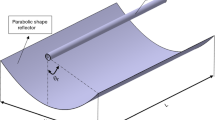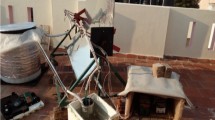Abstract
The aim of this experimental and modeling work is to compare the thermal efficiency of two identical parabolic trough solar collector systems under weather conditions in Amman, Jordan, using a hybrid nanofluid of MWCNTs and Y2O3 with gum Arabic surfactant, and distilled water as the heat transfer fluid (HTF). One parabolic trough collector (PTC) uses a hybrid nanofluid at four different volumetric concentrations (0.01, 0.025, 0.05, and 0.1%), while the other uses water as a HTF. To prepare the nanofluids and check their stability, the thermal efficiency of the PTC was examined for different hybrid nanofluid concentrations compared to distilled water. The results showed that the 0.1% MWCNTs and Y2O3 hybrid nanofluid had the highest thermal efficiency of 44.24%, while water had a thermal efficiency of 19.32%. In addition, increasing the concentrations resulted in an improvement in the maximum optical efficiency. The maximum efficiency of 45% was obtained using 0.1% Vol. The Solidworks model was created according to experimental setup parameters and dimensions. The simulation was conducted under steady-state operating conditions, incorporating dimensional governing equations (continuity, momentum, and energy). A uniform heat flux was applied with two primary boundary conditions: the first one was at the receiver inlet where the fluid inlet temperature and mass flow rate were specified, whereas the second one was at the receiver outlet, where the outlet pressure was equivalent to the atmospheric pressure. The obtained experimental results have been compared using the Solidwork simulation model, which was created to determine the PTC’s outlet temperature and thermal efficiency. The comparative results demonstrated remarkable precision with an average outlet temperature of 0.03% and thermal efficiency of 0.9%.
















Similar content being viewed by others

Abbreviations
- A :
-
Area /m2
- C :
-
Concentration ratio
- C p :
-
Specific heat capacity/J kg K−1
- D :
-
Diameter/m
- \(f\) :
-
Focal length/m
- \({F}_{{\text{R}}}\) :
-
Heat removal factor
- G :
-
Solar direct beam intensity/W m−2
- \(k\) :
-
Thermal conductivity/W m−1 K−1
- L :
-
Length/m
- \(\dot{m}\) :
-
Mass flow rate/kg s−1
- Q :
-
Heat flux/W
- T :
-
Temperature/K
- U :
-
Overall heat loss coefficient/W m−2 K−1
- W :
-
Width/m
- α :
-
Useful
- γ :
-
Intercept factor
- \(\Delta \) p :
-
Pressure drop/Pa
- ΔT :
-
Temperature difference/K
- ε :
-
Emittance
- η :
-
Efficiency/%
- θ :
-
Incident angle/°
- \({\varnothing }_{{\text{rim}}}\) :
-
Rim angle/°
- τ :
-
Transmittance
- ρ :
-
Density/kg m−3
- \( \rho _{{\text{c}}} \) :
-
Reflectance
- a:
-
Aperture
- amb:
-
Ambient
- ci:
-
Copper inner
- co:
-
Copper outer
- fm:
-
Fluid mean temperature
- gi:
-
Glass cover inner
- go:
-
Glass cover outer
- in:
-
Inlet
- L:
-
Loss
- nf:
-
Nanofluid
- np:
-
Nanoparticle
- o:
-
Optical
- out:
-
Outlet
- s:
-
Solar
- sun:
-
Sun
- th:
-
Thermal
- Useful:
-
Useful
- GA:
-
Gum Arabic
- HNF:
-
Hybrid nanofluid
- HTF:
-
Heat transfer fluid
- MWCNTs:
-
Multi-walled carbon nanotubes
- PTC:
-
Parabolic trough collector
- PTSCS:
-
Parabolic trough solar collector systems
- TF:
-
Thermal fluid
- Y2O3 :
-
Yttrium oxide
References
Hoang AT, Nižetić S, Olcer AI, Ong HC, Chen W-H, Chong CT, et al. Impacts of COVID-19 pandemic on the global energy system and the shift progress to renewable energy: opportunities, challenges, and policy implications. Energy Policy. 2021;154:112322. https://doi.org/10.1016/j.enpol.2021.112322.
Karunathilake H, Perera P, Ruparathna R, Hewage K, Sadiq R. Renewable energy integration into community energy systems: a case study of new urban residential development. J Clean Prod. 2018;173:292–307. https://doi.org/10.1016/j.jclepro.2016.10.067.
Chekifi T, Boukraa M. Thermal efficiency enhancement of parabolic trough collectors: a review. J Therm Anal Calorim. 2022;147(20):10923–42. https://doi.org/10.1007/s10973-022-11369-6.
Hachicha AA, Yousef BA, Said Z, Rodríguez I. A review study on the modeling of high-temperature solar thermal collector systems. Renew Sust Energ Rev. 2019;112:280–98. https://doi.org/10.1016/j.rser.2019.05.056.
Sharma M, Jilte R. A review on passive methods for thermal performance enhancement in parabolic trough solar collectors. Int J Energy Res. 2021;45(4):4932–66. https://doi.org/10.1002/er.6212.
Sepehrirad M, Aghaei A, Najafizadeh MM, Hassani JA. Investigating the effect of needle ribs on parabolic through solar collector filled with two-phase hybrid nanofluid. J Therm Anal Calorim. 2023. https://doi.org/10.1007/s10973-023-12772-3.
Dezfulizadeh A, Aghaei A, Sheikhzadeh GA. Comprehensive 3E analyses of a parabolic trough collector equipped with an innovative combined twisted turbulator. Eng Anal Bound Elem. 2023;150:507–27. https://doi.org/10.1016/j.enganabound.2023.02.032.
Pazarlıoğlu HK, Ekiciler R, Arslan K, Mohammed NAM. Exergetic, Energetic, and entropy production evaluations of parabolic trough collector retrofitted with elliptical dimpled receiver tube filled with hybrid nanofluid. Appl Therm Eng. 2023;223:120004. https://doi.org/10.1016/j.applthermaleng.2023.120004.
Arun M, Barik D, Sridhar K. Experimental and CFD analysis of dimple tube parabolic trough solar collector (PTSC) with TiO2 nanofluids. J Therm Anal Calorim. 2022;147(24):14039–56. https://doi.org/10.1007/s10973-022-11572-5.
Al-Oran O, Lezsovits F. Experimental study of thermal conductivity and viscosity of water-based MWCNT-Y2O3 hybrid nanofluid with surfactant. J Eng Thermophys. 2022;31(1):98–110. https://doi.org/10.1134/S1810232822010088.
Saddouri I, Rejeb O, Semmar D, Jemni A. A comparative analysis of parabolic trough collector (PTC) using a hybrid nanofluid. J Therm Anal Calorim. 2023;148(18):9701–21. https://doi.org/10.1007/s10973-023-12342-7.
Abed N, Afgan I, Cioncolini A, Iacovides H, Nasser A, Mekhail T. Thermal performance evaluation of various nanofluids with non-uniform heating for parabolic trough collectors. Case Stud Therm Eng. 2020;22:100769. https://doi.org/10.1016/j.csite.2020.100769.
Xiong Q, Hajjar A, Alshuraiaan B, Izadi M, Altnji S, Shehzad SA. State-of-the-art review of nanofluids in solar collectors: a review based on the type of the dispersed nanoparticles. J Clean Prod. 2021. https://doi.org/10.1016/j.jclepro.2021.127528.
Olia H, Torabi M, Bahiraei M, Ahmadi MH, Goodarzi M, Safaei MR. Application of nanofluids in thermal performance enhancement of parabolic trough solar collector: state-of-the-art. J Appl Sci. 2019;9(3):463. https://doi.org/10.3390/app9030463.
Rehan MA, Ali M, Sheikh NA, Khalil MS, Chaudhary GQ, ur Rashid T, et al. Experimental performance analysis of low concentration ratio solar parabolic trough collectors with nanofluids in winter conditions. J Renew Energy. 2018;118:742–51. https://doi.org/10.1016/j.renene.2017.11.062.
De los Rios MSB, Rivera-Solorio CI, García-Cuéllar AJ. Thermal performance of a parabolic trough linear collector using Al2O3/H2O nanofluids. J Renew Energy. 2018;122:665–73. https://doi.org/10.1016/j.renene.2018.01.094.
Subramani J, Nagarajan P, Mahian O, Sathyamurthy R. Efficiency and heat transfer improvements in a parabolic trough solar collector using TiO2 nanofluids under turbulent flow regime. J Renew Energy. 2018;119:19–31. https://doi.org/10.1016/j.renene.2017.11.079.
Subramani J, Nagarajan P, Wongwises S, El-Agouz S, Sathyamurthy R. Experimental study on the thermal performance and heat transfer characteristics of solar parabolic trough collector using Al2O3 nanofluids. Environ Prog Sustain. 2018;37(3):1149–59. https://doi.org/10.1002/ep.12767.
Ajay K, Kundan L. Combined experimental and CFD investigation of the parabolic shaped solar collector utilizing nanofluid (CuO-H2O and SiO2-H2O) as a working fluid. J Eng. 2016. https://doi.org/10.1155/2016/5729576.
Ayadi O, Hamdan M, Al-Far Y, Tayseer A, Al-Abbadi S, A’saf A et al., editors. Parametric Investigation of Nano-Fluids Utilization in Parabolic Trough Collector. In: 2021 12th International Renewable Engineering Conference (IREC); 2021: IEEE.
Ding Y, Alias H, Wen D, Williams RA. Heat transfer of aqueous suspensions of carbon nanotubes (CNT nanofluids). Int J Heat Mass Transf. 2006;49(1–2):240–50. https://doi.org/10.1016/j.ijheatmasstransfer.2005.07.009.
Ouni M, Ladhar LM, Omri M, Jamshed W, Eid MR. Solar water-pump thermal analysis utilizing copper–gold/engine oil hybrid nanofluid flowing in parabolic trough solar collector: Thermal case study. Case Stud Therm Eng. 2022;30:101756. https://doi.org/10.1016/j.csite.2022.101756.
Ekiciler R, Arslan K, Turgut O, Kurşun B. Effect of hybrid nanofluid on heat transfer performance of parabolic trough solar collector receiver. J Therm Anal Calorim. 2021;143:1637–54. https://doi.org/10.1007/s10973-020-09717-5.
Alkathiri AA, Jamshed W, Eid MR, Bouazizi ML. Galerkin finite element inspection of thermal distribution of renewable solar energy in presence of binary nanofluid in parabolic trough solar collector. Alex Eng J. 2022;61(12):11063–76. https://doi.org/10.1016/j.aej.2022.04.036.
Ekiciler R, Arslan K, Turgut O. Application of nanofluid flow in entropy generation and thermal performance analysis of parabolic trough solar collector: experimental and numerical study. J Ther Anal Calorim. 2023;11:1–20. https://doi.org/10.1007/s10973-023-12187-0.
Allauddin U, Rafique MU, Malik O, Rashid O, Waseem A, King P, et al. Investigation of the thermo-hydraulic performance of a roughened parabolic trough collector. Appl Therm Eng. 2023;219:119523. https://doi.org/10.1016/j.applthermaleng.2022.119523.
Esfe MH, Behbahani PM, Arani AA, Sarlak MR. Thermal conductivity enhancement of SiO2–MWCNT (85: 15%)–EG hybrid nanofluids. J Therm Anal Calorim. 2017;128(1):249–58. https://doi.org/10.1007/s10973-016-5893-9.
Upadhyay BH, Patel AJ, Sadasivuni KK, Mistry JM, Ramana PV, Panchal H, Ponnamma D, Essa FA. Design, development and techno economic analysis of novel parabolic trough collector for low-temperature water heating applications. Case Studies Therm Eng. 2021;1(26):100978. https://doi.org/10.1016/j.csite.2021.100978.
Abed N, Afgan I, Iacovides H, Cioncolini A, Khurshid I, Nasser A. Thermal-hydraulic analysis of parabolic trough collectors using straight conical strip inserts with nanofluids. J Nanomater. 2021;11(4):853. https://doi.org/10.3390/nano11040853.
Pavlovic S, Bellos E, Stefanovic V, Tzivanidis C. Optimum geometry of parabolic trough collectors with optical and thermal criteria. Int Rev Appl Sci Eng. 2017;8(1):45–50. https://doi.org/10.1556/1848.2017.8.1.7.
Al-Oran O, A’saf A, Lezsovits F. Experimental and modelling investigation on the effect of inserting ceria-based distilled water nanofluid on the thermal performance of parabolic trough collectors at the weather conditions of Amman: a case study. J Energy Reports. 2022;8:4155–69. https://doi.org/10.1016/j.egyr.2022.03.030.
Holman JP. Experimental methods for engineers. 2012.
Moraveji MK, Ardehali RM. CFD modeling (comparing single and two-phase approaches) on thermal performance of Al2O3/water nanofluid in mini-channel heat sink. Int Commun Heat Mass Transf. 2013;44:157–64. https://doi.org/10.1016/j.icheatmasstransfer.2013.02.012.
Tzivanidis C, Bellos E, Korres D, Antonopoulos K, Mitsopoulos G. Thermal and optical efficiency investigation of a parabolic trough collector. Case Stud Therm Eng. 2015;6:226–37. https://doi.org/10.1016/j.csite.2015.10.005.
Gupta N, Gupta SM, Sharma S. Preparation of stable metal/COOH-MWCNT hybrid nanofluid. J Materials Today: Proceedings. 2021;36:649–56. https://doi.org/10.1016/j.matpr.2020.04.492.
Inc. URN. Nanomaterials Catalog. US Research Nanomaterials, Inc., Houston, TX, USA. 2021. https://www.us-nano.com/home.
Rasih RA, Sidik NAC, Samion S. Recent progress on concentrating direct absorption solar collector using nanofluids. J Therm Anal Calorim. 2019;137(3):903–22. https://doi.org/10.1007/s10973-018-7964-6.
Al-Oran O, Lezsovits F, Aljawabrah A. Exergy and energy amelioration for parabolic trough collector using mono and hybrid nanofluids. J Therm Anal Calorim. 2020;140(3):1579–96. https://doi.org/10.1007/s10973-020-09371-x.
Author information
Authors and Affiliations
Corresponding author
Additional information
Publisher's Note
Springer Nature remains neutral with regard to jurisdictional claims in published maps and institutional affiliations.
Rights and permissions
Springer Nature or its licensor (e.g. a society or other partner) holds exclusive rights to this article under a publishing agreement with the author(s) or other rightsholder(s); author self-archiving of the accepted manuscript version of this article is solely governed by the terms of such publishing agreement and applicable law.
About this article
Cite this article
Al-Oran, O., Shaban, N.A., Manna, R. et al. Performance study of parabolic trough solar collector using hybrid nanofluids under Jordanian weather conditions. J Therm Anal Calorim 149, 3981–3998 (2024). https://doi.org/10.1007/s10973-024-12961-8
Received:
Accepted:
Published:
Issue Date:
DOI: https://doi.org/10.1007/s10973-024-12961-8



